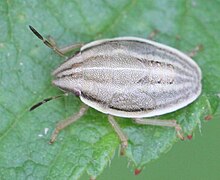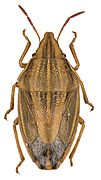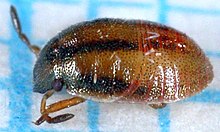Aelia acuminata
| Aelia acuminata | |
|---|---|

| |
| Scientific classification | |
| Domain: | Eukaryota |
| Kingdom: | Animalia |
| Phylum: | Arthropoda |
| Class: | Insecta |
| Order: | Hemiptera |
| Suborder: | Heteroptera |
| Family: | Pentatomidae |
| Genus: | Aelia |
| Species: | A. acuminata
|
| Binomial name | |
| Aelia acuminata | |
| Synonyms | |
| |
Aelia acuminata, common name bishop's mitre, is a species of shield bug belonging to the family Pentatomidae.[1]
Distribution
This species is present in most of Europe, in North Africa and in Northern Asia (excluding China).[2][3]
Habitat
These shield bugs mainly inhabit dry meadows and fields of cereals.[4] They occurs in the Alps up to about 1300 meters above sea level.
Description
Aelia acuminata can reach a length of 5–9 millimetres (0.20–0.35 in).[4] These bugs have a slightly elongated body, with a pointed head (hence the species name acuminata). The basic body color is light brown with darker brown longitudinal. The nymphs are already rather similar to the adults, although they are still wingless.
Biology
Aelia acuminata is a univoltine species. They have five nymphal stages in their development. Adults overwinter in litter or thickets. These bugs are herbivorous, feeding on various wild grasses and cereals. They suck many different types of grasses (Poaceae), mainly Festuca, Poa, Agrostis, Dactylis, Lolium and Bromus species. They can cause significant damage in cereal fields.
Gallery
-
Mating. Video clip
-
Nymph.
-
Adults feeding on Phalaris arundinacea
-
Museum specimen
-
Nymph, first stage
-
Nymph, last instar
Bibliography
- Michael Chinery, Insectes de France et d'Europe occidentale, Paris, Flammarion, août 2012, 320 p. (ISBN 978-2-0812-8823-2), p. 72-73
- Amyot, C. J. B., and Audinet Serville (1843), Histoire Naturelle des Insectes Hémiptères
- Ruiz, D., M. Goula, E. Infiesta, T. Monleón, M. Pujol, and E. Gordún (2003) Guía de identificación de los chinches de los cereales (Insecta, Heteroptera) encontrados en los trigos españoles, Boletín de Sanidad Vegetal, vol. 29, no. 4
References
- ^ Biolib
- ^ "Catalogue of life". Archived from the original on 2020-01-15. Retrieved 2018-05-02.
- ^ Fauna europaea
- ^ a b NATUR-IN-NRW




